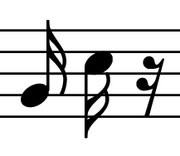
Sixteenth note
Encyclopedia


Music
Music is an art form whose medium is sound and silence. Its common elements are pitch , rhythm , dynamics, and the sonic qualities of timbre and texture...
, a sixteenth note (American) or semiquaver (also occasionally demiquaver) is a note
Note
In music, the term note has two primary meanings:#A sign used in musical notation to represent the relative duration and pitch of a sound;#A pitched sound itself....
played for one sixteenth the duration of a whole note
Whole note
thumb|right|250px|Figure 1. A whole note and a whole rest.In music, a whole note or semibreve is a note represented by a hollow oval note head, like a half note , and no note stem . Its length is equal to four beats in 4/4 time...
, hence the name. The semiquaver is half of a quaver which is an eighth note.
Sixteenth notes are notated with an oval, filled-in note head
Note head
In music, a note head is the elliptical part of a note. Noteheads may be coloured completely black or white, indicating the note value . In a whole note, the note head is the only component of the note. Shorter note values attach a stem to the note head, and possibly beams or flags...
and a straight note stem with two flags. (see Figure 1). A similar symbol is the sixteenth rest (or semiquaver rest), which denotes a silence for the same duration. As with all notes with stems, sixteenth notes are drawn with stems to the right of the notehead, facing up, when they are below the middle line of the musical staff. When they are on or above the middle line, they are drawn with stems on the left of the note head, facing down. Flags are always on the right side of the stem, and curve to the right. On stems facing up, the flags start at the top and curve down; for downward facing stems, the flags start at the bottom of the stem and curve up. When multiple sixteenth notes or eighth note
Eighth note
thumb|180px|right|Figure 1. An eighth note with stem facing up, an eighth note with stem facing down, and an eighth rest.thumb|right|180px|Figure 2. Four eighth notes beamed together....
s (or thirty-second notes, etc.) are next to each other, the flags may be connected with a beam
Beam (music)
A beam in musical notation is a thick line frequently used to connect multiple consecutive eighth notes , or notes of shorter value , and occasionally rests...
, like the notes in Figure 2. Note the similarities in notating sixteenth notes and eighth note
Eighth note
thumb|180px|right|Figure 1. An eighth note with stem facing up, an eighth note with stem facing down, and an eighth rest.thumb|right|180px|Figure 2. Four eighth notes beamed together....
s. Similar rules apply to smaller divisions such as thirty-second note
Thirty-second note
In music, a thirty-second note or demisemiquaver is a note played for 1/32 of the duration of a whole note...
s (demisemiquavers) and sixty-fourth note
Sixty-fourth note
In music notation, a sixty-fourth note or hemidemisemiquaver is a note played for 1/64 of the duration of a whole note . It lasts half as long as a thirty-second note ....
s (hemidemisemiquavers).
In Unicode
Unicode
Unicode is a computing industry standard for the consistent encoding, representation and handling of text expressed in most of the world's writing systems...
, U+266C (♬) is a pair of beamed semiquavers.
The note derives from the semifusa in mensural notation
Mensural notation
Mensural notation is the musical notation system which was used in European music from the later part of the 13th century until about 1600."Mensural" refers to the ability of this system to notate complex rhythms with great exactness and flexibility...
. However, semifusa also designates the modern sixty-fourth note in Spanish.
The name of this note (and rest) in European languages varies greatly:
| Language | note name | rest name |
|---|---|---|
| Dutch | zestiende noot | zestiende rust |
| German | Sechzehntelnote | Sechzehntelpause |
| French | double-croche | quart de soupir |
| Italian | semicroma | pausa di semicroma |
| Spanish | semicorchea | silencio de semicorchea |
| Portuguese | semicolcheia | pausa de semicolcheia |
| Russian | шестнадцатая нота | шестнадцатая пауза |
| Greek | δέκατο έκτο | παύση δεκάτου έκτου |

